The Jacquinot Safe Zone 饶家驹安全区

这个藏点是为了纪念伟大的饶家驹神父 Father Robert Jacquinot de Besange, S.J.在为保护上海人民所做的一切。
1937年,当日本军队进攻上海时,一位法国耶稣会士Robert Jacquinot de Besange, S.J.神父(中文名:饶家驹)英勇地站出来维护平民的生命,饶家驹神父在中国生活了27年,他决心为现代战争的受害者提供安全和庇护。通过不懈的谈判和巧妙的外交手段,饶家驹神父说服了日本和中国的军事领导人,允许在持续的战争中建立饶家驹安全区。饶家驹神父的举措后来被其他中国城市效仿,并在残酷的中日战争期间拯救了50多万中国平民的生命。1949年《日内瓦公约》的《议定书》和《评注》中都提到了饶家驹区的名字。
The English version was translated by AI, so please forgive any inaccuracies.
This cache is dedicated to the memory of the great Father Robert Jacquinot de Besange, S.J. for all he did to protect the people of Shanghai.
When Japanese forces attacked Shanghai in 1937, a French Jesuit, Father Robert Jacquinot de Besange, S.J., heroically stood up for human life. Father Jacquinot, who spent twenty-seven years in China, was determined to provide safety and refuge to victims of modern warfare. Through relentless negotiations and deft diplomacy, Father Jacquinot convinced Japanese and Chinese military leaders to allow for the establishment of a safe zone in the midst of the ongoing war. Father Jacquinot’s example was subsequently copied in other Chinese cities and saved the lives of more than half a million Chinese civilians over the course of the brutal Sino-Japanese war. The Jacquinot Zone is mentioned by name in both the Protocols and Commentaries to the Geneva Convention of 1949.
饶家驹神父在建立安全区前 Before the founding of the safe zone
饶家驹神父出生于1878年3月15日,出生地是法国西部夏朗德省的桑特小镇。16岁时,加入耶稣会,稣会。由于20世纪初法国局势的变化,耶稣会被驱逐出法国,饶家驹无法在法国完成他的宗教学业,因此他辗转英国、比利时等好几个国家,经历了19年的培训后,才正式成为一名传教士。在完成学业后不久,饶家驹就被派到上海传教。这是1913年,第一次世界大战爆发的前一年。
他来到上海后,被委派到了徐家汇,他很快学会了中文,和民众打成一片,起了个中文名字:饶家驹,推测是因为饶家驹的上海话发音和Jacquinot较为接近。
他同时兼任徐汇公学(现徐汇中学)的监学,教法语和化学,兼任震旦大学(现交通大学医学院)英国语言与文学教授,教授英语和自然科学。
1914年5月,饶家驹在制作烟火时发生意外,被炸断了右臂。
在1914年到1934年间,他还担任虹口圣心堂的神父,在与日本侨民接触中,学会了日语。这为他今后与日军谈判沟通打下了基础。
Father Jacquinot was born on March 15, 1878 in the small town of Saintes in the western French province of Charente. At the age of 16, he joined the Society of Jesus. Due to the changing situation in France in the early 20th century, the Society of Jesus was expelled from France.He was unable to complete his religious studies in France. Therefore, he traveled to several countries, including England and Belgium, and after 19 years of training, he officially became a missionary. Shortly after completing his studies, Father Jacquinot was sent to Shanghai to preach in 1913, the year before the outbreak of World War I.
After arriving in Shanghai, he was assigned to Xujiahui, where he quickly learned Chinese and became close to the local people. He took on a Chinese name, 饶家驹, which is believed to be because his Shanghai dialect pronunciation was similar to “Jacquinot”.
He also served as the supervisor of Xuhui Public School (now Xuhui Middle School), teaching French and chemistry, and as a professor of English language and literature and natural science at St. John’s University (now the School of Medicine of Shanghai Jiao Tong University).
In May 1914, Father Jacquinot had an accident while making fireworks and lost his right arm.
From 1914 to 1934, he also served as a priest at the Holy Heart Church in Hongkou, where he learned Japanese through contact with Japanese immigrants. This laid the foundation for his future negotiations and communication with the Japanese army.
Let’s geocaching
如果你不想按照我设定的路线走,请直接在这个“城隍庙”景区里找一个纪念饶家驹的纪念碑。直接到达下面的环节7。理论上不需要门票。
If you don’t want to follow the route I’ve set out, look for a plague to the Jacquinot Safe Zone in this “City god temple” and “Yu yuan” scenic areas. Go straight to Stage 7 below. No entrance fee is needed.
1. 豫园地铁站1号出口 Exit 1 of Yuyuan Subway Station.
从1号出口出来,你会发现你正在一个路口,向北看,面前的这条人民路就是当时上海县城与法租界的分界线。
如果站在租界往南看,这里就曾经是老北门也称为晏海门的铁门所在的位置。当时这里是这样的:
Coming out of Exit 1, you will find yourself at an intersection. Looking north, the road in front of you, Renmin Road, was the boundary between Shanghai County and the French Concession at that time.
If you stand in the concession and look south, this was the location of the Old North Gate, also known as the Yanhai Gate. An iron Gate was there. At that time, it looked like this:
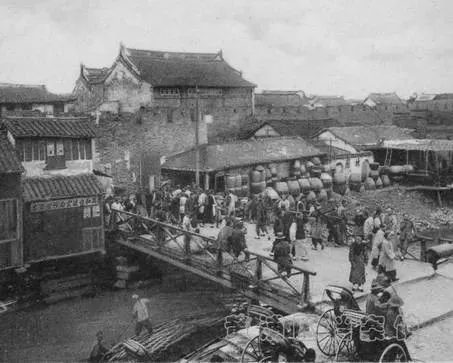
1937年8月13日,日军向宝山路的中国守军发起了进攻,大批平民受难,向法租界及公共租界涌去。在战火点燃后,每天都有无数难民,甚至于外地的难民都希望进入租界,仅“八一三”当天,就6万人进入租界。由于难民太多,法租界将租界与上海县城间的铁门进行了管制,定时开放,因此每天都会有大量难民在铁门前等候开门。
On August 13, 1937, the Japanese army launched an attack on the Chinese defenders on Baoshan Road, causing a large number of civilians to suffer and flee to the French Concession and the International Concession. After the outbreak of the war, countless refugees, including those from other provinces, flooded into the concessions every day. On the day of the “8.13 Incident” alone, 60,000 people entered the concessions. Due to the overwhelming number of refugees, the French Concession began to regulate the iron gate between the concession and Shanghai County, opening it at scheduled times. As a result, large numbers of refugees would wait in front of the gate every day.
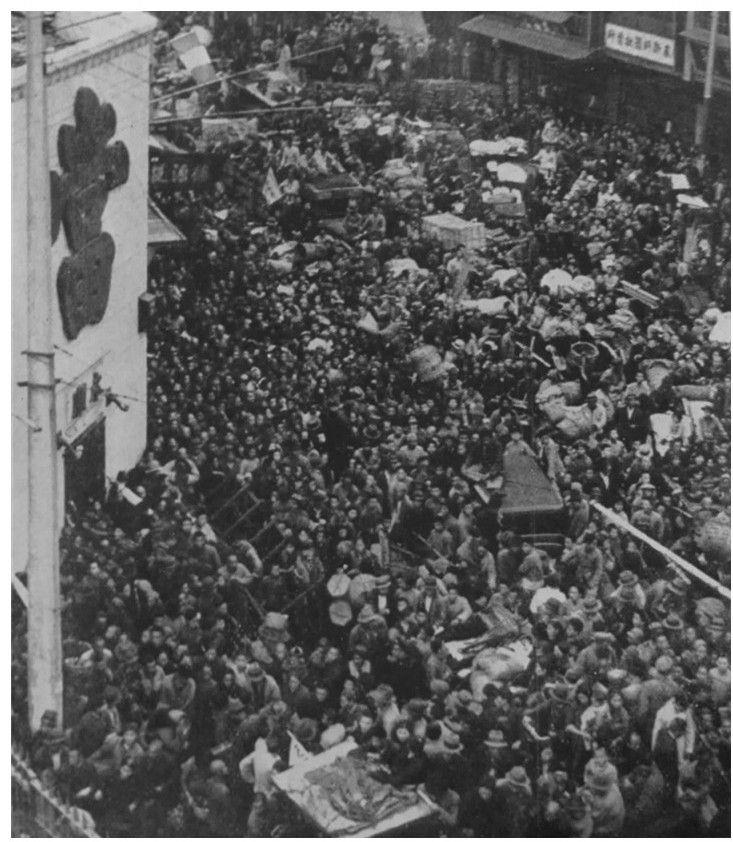
不要过马路,回头,我们延着路向南走,在第一个路口左转向东。
Do not cross the road. Instead, turn around and head south along the road. At the first intersection, turn left to the east.
2. 清真寺 Mosque
作为上海国际红十字会的副主席及其下属的难民委员会的主席,饶家驹开始在南市物色一块地方作为保护难民的安全区,这将是25万中国等国的难民躲避战火的天堂。饶家驹亲笔起草了一封信,信上有他和市长的联合签名,信的内容是,在南市划出一块区域作为难民的避难所,设置为安全区(也被称为南市难民区,本文后续使用“饶家驹安全区”这个名字),日本军队不得对此发动进攻。信中明确指出,安全区东面、北面和西面以法租界南面的民国路为界,南面以方浜路为界。为了设立安全区,饶家驹神父开始同中日当局进行了紧张的秘密谈判,谈判持续了三天三夜。
最终安全区得以设立。
As the Vice Chairman of the Shanghai International Red Cross and the Chairman of the Refugee Committee under its jurisdiction, Father Jacquinot began to search for a place in the Nanshi District (also be called Nantao) to serve as a safe haven for refugees. This would become a paradise for 250,000 refugees from China and other countries to escape the war. Father Jacquinot personally drafted a letter, co-signed by himself and the mayor of Shanghai, requesting that an area be designated in the Nanshi District as a refuge for refugees and established as a safe zone (also known as the “Jacquinot Safe Zone”). The letter explicitly stated that the area to the east, north, and west of the safe zone would be bounded by the Renmin Road south of the French Concession, and to the south by Fangbang Road. In order to establish the safe zone, Father Jacquinot began secret negotiations with Chinese and Japanese authorities, which lasted for three days and three nights.
In the end, the safe zone was established.
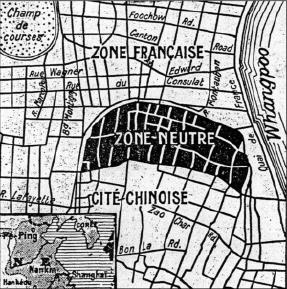
如果按着指示走,在这里你会看到一个清真寺,在安全区设立后,这里也是难民收容地之一。在这里,你可以看到一段古兰经文,后面写着 A:B
If you follow the directions, here you will see a mosque, which was also one of the places where refugees were sheltered after the creation of the safe zone. Here you will find a Qur’anic verse followed by the numbers A:B
3. 珠玉业公会 Jewelry Industry Association
上海开埠后,工商业迅速发展起来,各行业为维护自身利益,纷纷设立行业会所。清末豫园败落,城内各行业集议修复,议定豫园由出资修得者使用,出资各行业公所落户豫园。
过了清真寺,在第一个路口向右转,你会看到一个上海的老字号,当时这里的珠玉业公会,始建于清同治十二年(1883年),名仰止堂,二层砖木结构,有大殿、议事厅、客舍等建筑,是珠宝玉器业设市贸易之所。
安全区设立后,不少行业公所也纷纷开放,收容了不少难民,珠玉业公会也是其中之一。
这个地方的门牌号是C
After the opening of Shanghai, the rapid development of industry and commerce, various industries to protect their own interests, have set up industry associations. At the end of the Qing Dynasty, the Yuyuan Garden fell into disrepair, and the various industries in the city gathered to discuss the restoration, and agreed that the Yuyuan Garden would be used by those who funded the repair. Various industry associations settled in the Yuyuan Garden.
After the mosque, in the first intersection to the right, you will see an jewelry shop, when the Jewelry Industry Association was settled here. What you see now is the reconstructed building. The original building was built in the twelfth year of the Qing Dynasty Tongzhi (1883), named Yangzhi Hall, two-story brick structure, with a large hall, council chambers, guest houses and other building.
After the establishment of the Safety Zone, many industry offices were opened to accommodate many refugees, and the Jewelry Industry Association was one of them.
The door number of this place is C
4. 禅寺 Temple
这里本是豫园园主潘允端供奉沉香木观音像的家祠,清嘉庆年间由上海道及知县集资重建,更名为“慈云禅寺”。《申报》1937年11月18日报道了国际救济会调查难民区内难民确数,查得“沉香阁六〇〇人”,由此可见沉香阁当时收容了大量难民。今沉香阁为一处重要的佛教场所。
这里可以看到一个牌楼,在牌楼上有一个黑色匾额,上面写着禅寺的名字。在匾额的正下方,有D个小动物。
It was originally a family shrine where the owner of Yuyuan Garden, Pan Yunduan, enshrined the Goddess of Mercy statue. It was rebuilt during the Jiaqing period of the Qing Dynasty by local governor, and renamed “Ci Yun Zen Temple”. November 18, 1937, reported in the newspaper “Declaration The International Relief Society investigated the exact number of refugees in the refugee area and found that there were “600 people accomodated here”, which shows that the temple housed a large number of refugees at that time. Today, here is an important Buddhist site.
Here you can see a pagoda with a black plaque on which the name of the temple is written. Right below the plaque, there are D small animals.
5. 游乐场 Amusement park
你可以看到一个白色的建筑,这个建筑与周围的环境似乎不怎么协调,在这个建筑建成时,是一个三层游乐场。
11月9日,安全区成立第一天,这个游乐场就收容了1200难民,而整个安全区内共收容2万余人。
在这个建筑的东侧有一个进入景区的入口,进入景区。
You can see a white building, which does not seem to be in harmony with its surroundings, and at the time this building was built, it was a three-story amusement park.
On November 9, the first day of the safe zone, this playground housed 1,200 refugees, while the entire safe zone housed more than 20,000 people.
There is an entrance on the east side of this building, which is numbered E, into the scenic area. Please take some time to enjoy your tour here.
6. 饶家驹办公点 Father Jacquinot’s office
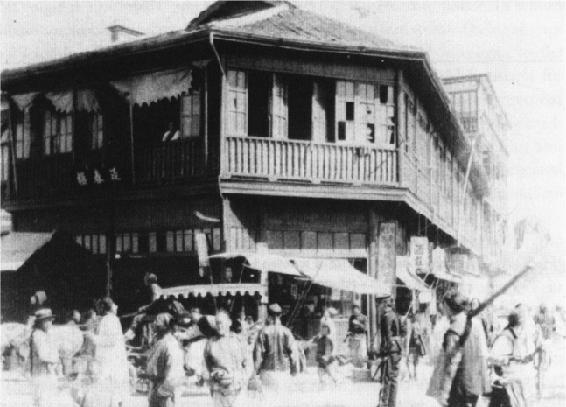
11月15日,国际救济会南市难民区办事处成立,这里就是饶家驹神父处理保证这个安全区运转的办公地点,当时这个建筑有三层,饶神父在第三层。就是在这里,他思考着如何为25万人提供吃穿用度,如果处理与日军及上海当局的关系,解决突发事件,保证这个小规模城镇的治安和正常运行。
整个安全区的运作,除了中国政府和广大上海民众的捐款,饶神父还远赴美国,并与时任总统罗斯福会面,并得到支持和帮助,获得了来自美国的70万美元捐助。
On November 15, the International Relief Society’s Nanshi Refugee Zone Office was established, and this is where Father Jacquinot handled the office that ensured the functioning of this safe zone. The building had three floors at the time, and Father Jacquinot was on the third floor. It was here that he thought about how to feed and clothe 250,000 people, and how to handle relations with the Japanese army and the Shanghai authorities, to solve emergencies, and to ensure the security and normal functioning of this small-scale town.
The entire safe zone was run with donations from the Chinese government and the general Shanghai public, but Father Jacquinot also went as far as the United States and met with then President Roosevelt and received support and help in the form of a $700,000 donation from the United States.
7. 纪念碑 The Plague
这个藏点最大的挑战就是去寻找一个纪念这段历史的纪念碑。
2017年,在苏志良教授及其它相关人士的呼吁下,上海南市难民区纪念碑在2017年12月14日正式揭幕,请找到这块纪念碑,上面用中文写着安全区的介绍。这个纪念碑很难找,个人认为设置的地方并不合理,而且只有在白天才可以到达碑前,如果有人阻拦,可以向他说明,你只是想看一下这块碑,他应该是会让你去的,或至少你能拍到一张照片。
Your biggest challenge here is to find a plague or monument to this history.
In 2017, the plague of Shanghai Nanshi Refugee Zone was officially unveiled on December 14, 2017 under the appeal of Professor Su Zhiliang and other related people, please find this plague with the introduction of the safety zone in Chinese. This plague is hard to find, personally I don’t think it is set in a good place, and you can only reach the plague during the day. If someone stops you, you can explain to him that you just want to see the monument, and he may let you go. Or at least you could take a photo at the outside.
Sorry the momument is written in Chinese. But at the end you could find:
“Safety Zone of Nantao La Jacquinot Zone”
面对纪念碑,在纪念碑的左侧,有两位神话人物,他们的衣服上有F个动物。
Facing the plague, to the left of it, are two mythological figures with F animals on their clothes.
安全区的关闭,饶家驹回国
Closure of the Safety Zone, Father Jacquinot return to France
从1937年11月9日正式建立到1940年6月30日宣告结束,南市难民区一共存在了963天之久,先后保护了30万中国难民。
1940年6月16日,德国入侵法国,饶家驹受招回到法国,同样从事着建立安全区,求助难民的工作。1945年5月,德国投降后,具有大爱精神的饶家驹,又背起行囊,前往柏林,去救助德国难民。作为一个法国人,他不计前嫌地帮助这个曾侵略过自己国家、给法国带来无穷灾难的国家的人民。在他的眼里,只有受苦受难的人,而没有敌与友的区分。
From its official establishment on November 9, 1937 to its declaration of closure on June 30, 1940, the Jacquinot Zone existed for a total of 963 days, protecting 300,000 Chinese refugees in succession.
After the German invasion of France on June 16, 1940, Father Jacquinot was recruited to return to France, where he was also engaged in establishing a safety zone and helping refugee. In May 1945, after the German surrender, Father Jacquinot, who had a great spirit of love, took up his bag and went to Berlin to help the German refugees. As a Frenchman, he helped the people of the country that had invaded his own country and brought endless disasters to France. Regardless of the past, in his eyes, there were only people who suffered, and there was no distinction between friend and foe.
饶家驹神父的最后归宿 Father Jacquinot’s final destination
1946年9月初,饶家驹因为过于虚弱摔了一跤,住进了柏林的医院,不得不放下了他心心念念的救济难民的工作。此时,医生诊断出他罹患了晚期白血病。仅数天后,9月10日16时40分,饶家驹平静而安详地离开了人世。
饶家驹离世的噩耗迅速传到了上海,各大报刊对饶家驹的去世表示了沉痛哀悼。9月18日,上海的民众,尤其是接受过饶家驹帮助的人们,特意在饶家驹曾工作过的圣伯多禄天主堂举办追思弥撒。而南市旧难民区的教外人士也要求在圣若瑟堂为饶家驹举办追思弥撒,许多原来的难民扶老携幼,从四面八方赶来,参加了这次典礼。
最初,饶家驹被安葬在弗瑙的法国国家公墓。1951年,法国国家公墓改建搬迁,墓地中安葬者的遗骨大多被迁回法国,而饶家驹的家族已经没有后人,他的墓地留在了柏林,圣湖柏林湿地公墓。
At the beginning of September 1946, Father Jacquinot was admitted to a hospital in Berlin because he had fallen too weak. He had to leave his work as a refugee relief worker, which he had longed for. At this time, doctors diagnosed him with advanced leukemia. Only a few days later, at 16:40 on September 10, Father Jacquinot passed away peacefully and quietly.
On September 18, the people of Shanghai, especially those who had received help from Father Jacquinot, held a memorial mass at St. Peter’s Catholic Church, where Father Jacquinot had worked. The lay people of the old refugee area in Nanshi also requested that a memorial Mass be held for Father Jacquinot at St. Joseph’s Church, and many of the original refugees came from all directions with their children and elderly to attend the ceremony.
In 1951, when the French National Cemetery was moved, most of the remains of those buried there were moved back to France, and Father Jacquinot’s family no longer had any descendants, so his grave was left in Berlin, at the Berlin Wetland Cemetery on the Holy Lake.
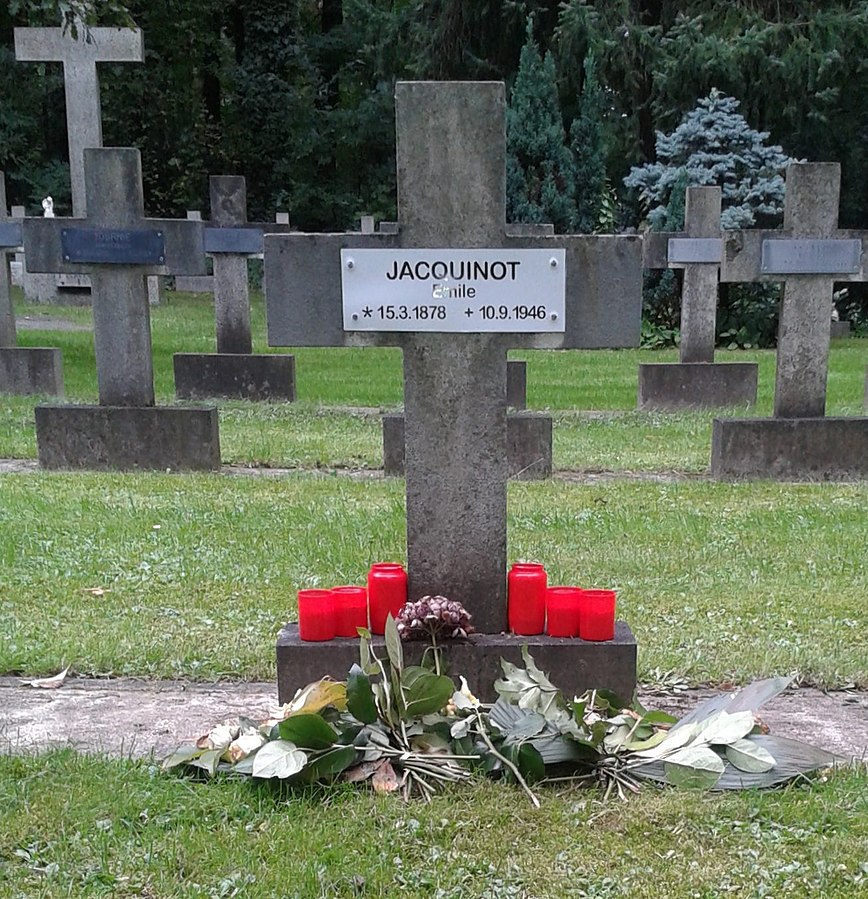
2013年年9月,在德国西柏林的法国公墓区内举行了伟大的人道主义者饶家驹先生的墓地揭幕仪式,中国、法国、德国的外交官、历史学者、教会代表、媒体代表等出席,饶家驹的墓碑上覆盖着一面硕大的用中、法、德三国国旗拼接而成的旗帜,中国学者余秋雨还特意为饶家驹的墓碑题写了“仁者爱人”四个字,并雕刻在玉片上,镶嵌在墓碑上。
In September 2013, the grave of the great humanitarian Father Jacquinot was unveiled in the French cemetery area in West Berlin, Germany. In the presence of Chinese, French and German diplomats, historical scholars, church representatives and media representatives, etc. Father Jacquinot’s tombstone was covered with a large flag stitched together with Chinese, French and German flags, and the Chinese scholar Yu Qiuyu inscribed Father Jacquinot’s tombstone with the words “The benevolent one loves people”, which were engraved on jade pieces and set on the tombstone.
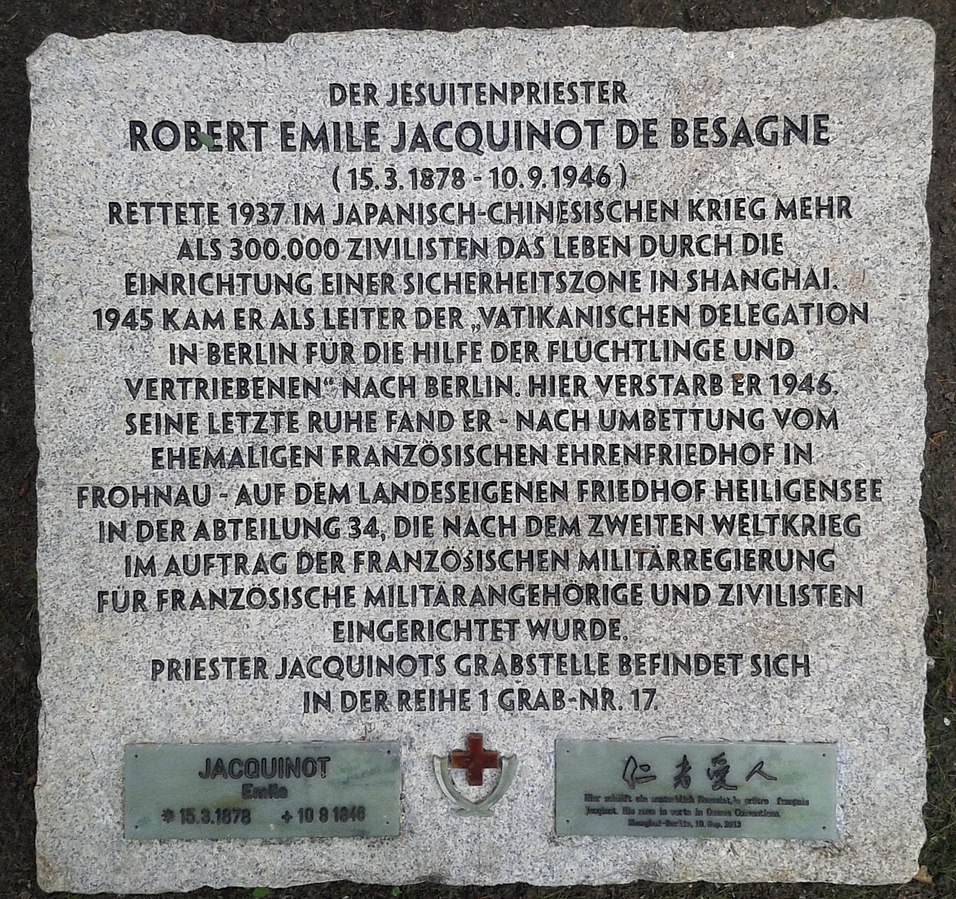
后记及感谢 Postscript and Thanks
后记 Postscript
在了解了到饶家驹神父的事迹后,我心潮澎湃,原安全区的所在地,是我从小就非常熟悉的地方,我有很多认识的人就生活在那处区域附近,我猜想会不会有他们的祖辈可能就曾经在安全区中生活过。而这段历史并不被我们熟知,我甚至从来没有听说过。好在近年来这段历史又重新被挖掘,我和苏教授有同样的感受,南市的建筑基本都要被拆完了,那些历史上的地点正在逐渐消失,我也希望通过这个藏点能让更多的人知道这位伟大的神父和这段历史。
可惜的是,我是在得到 Virtual Reward 之后才知道这段历史的,否则我一定会这个 Reward 用在这个主题上。我希望这个藏点能永远存在下去,即使在未来我无力继续 Geocaching 的时候。
After learning about the exploits of Father Jacquinot, I was overwhelmed by the site of the original Safety Zone, a place I had known very well since I was a child, and I had many people I knew who lived near that area. I wondered if any of their grandparents might have lived in the Zone. And this history was not well known to us, I had never even heard of it. Well in recent years this history has been re-discovered and I feel the same way as Professor Su. The buildings in the Nashi District are basically going to be torn down and those historical locations are disappearing. I hope that through this hiding spot more people will know about this great priest and this history.
Unfortunately, I only found out about this history after I used the Virtual Reward, otherwise I would have used this Reward for this theme. I hope that this cache will last forever, even if I am unable to continue Geocaching in the future.
感谢 Thanks
感谢苏智良教授,因为他的努力挖掘和深入考证,饶家驹的事迹被更多的国人了解,他的《饶家驹与战时平民保护》和《上海拉贝:饶家驹》这两本书也是目前了解这段历史和饶家驹生平的最佳中文读物。
感谢 Marcia R. Ristaino 因为她的 《The Jacquinot Safe Zone》 这本书,让更多其它国家的人了解了这段历史和神父的伟大义举。
本文中的文字及照片基本都来自于上述书籍及网络。
Thanks to Professor Su Zhiliang, whose efforts and in-depth research have made Father Jacquinot’s story more widely known to the Chinese people, his books “Jacquinot and Civil Protection in Wartime and Shanghai” and “Shanghai Rabe: Father Jacquinot” are the best Chinese books available on the history and life of Father Jacquinot.
Thanks to Marcia R. Ristaino’s book “The Jacquinot Safe Zone”, more people in other countries have been able to learn about this history and the great deeds of the priest.
The text and photographs in this article are largely taken from the above-mentioned book and the internet.
本网站内容如无特别注明,均为geocaching.cn原创,转载请以链接形式标明本文地址。
本文地址:http://www.geocaching.cn/2023/06/the-jacquinot-safe-zone/